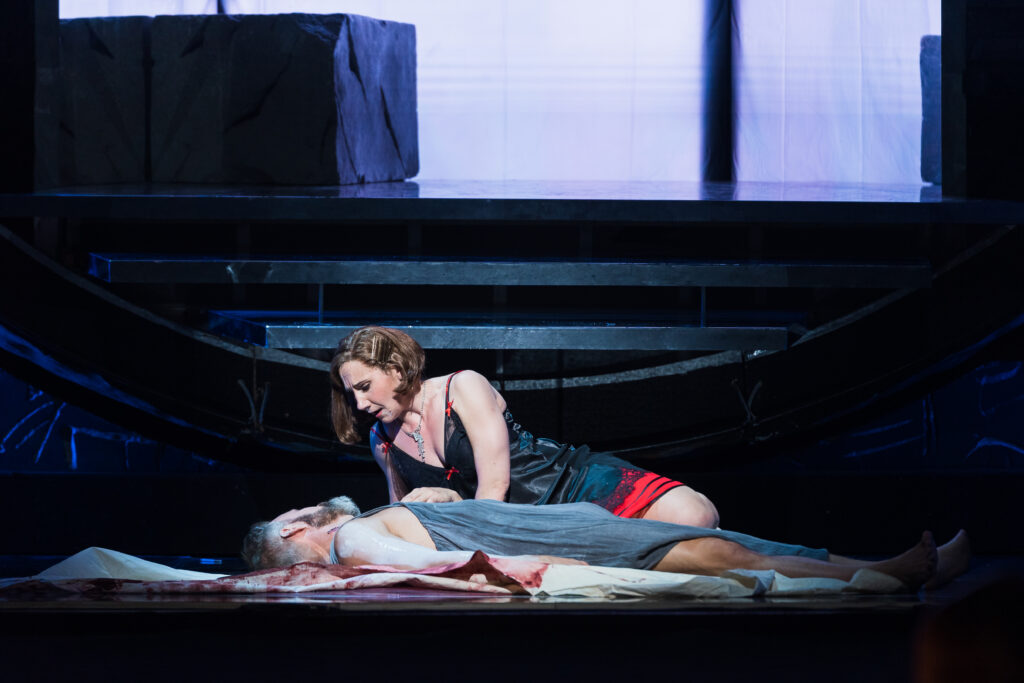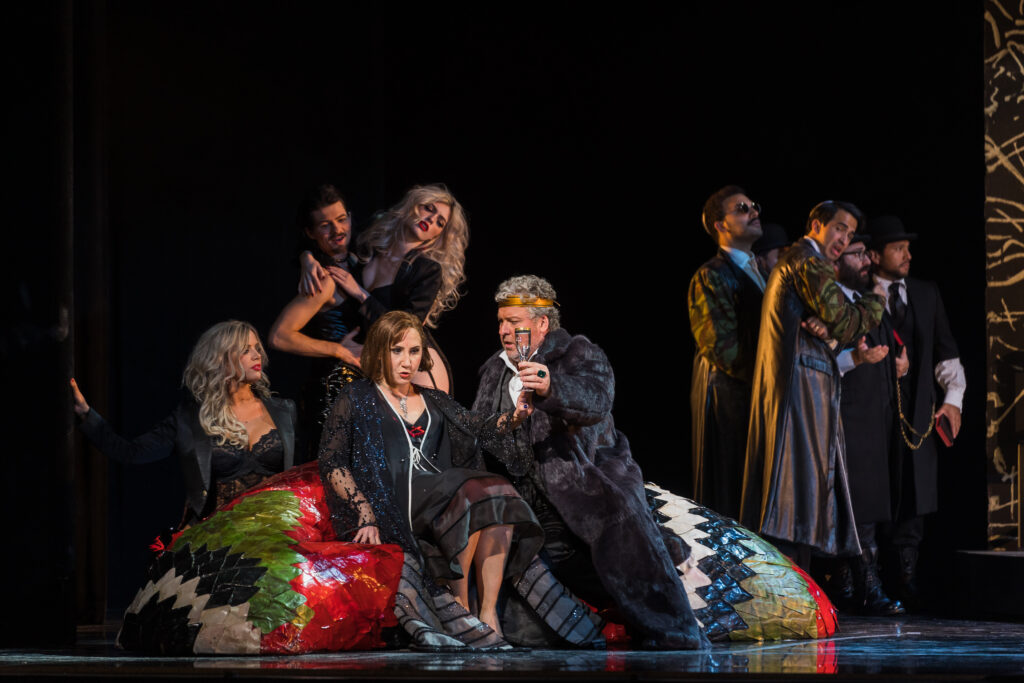Houston Grand Opera delivers a startling, vivid “Salome”

Before any music sounds, the lights go up on a rowdy party. At the edge of the room, a fight erupts. The guy who gets the short end of it winds up being carried out, and the revelry rolls on.
In Herod’s palace, as incarnated in Houston Grand Opera’s production of Strauss’ Salome, life is cheap.
Stage director Francisco Negrin amps up the tale of obsession and killing that so shocked audiences when Salome was new, laying out the lurid events — based on a biblical reference fleshed out by Oscar Wilde — in fresh ways to chill 21st Century viewers. The red-blooded singing and hefty, colorful playing in the pit, led by conductor Keri-Lynn Wilson, lend their own walloping impact.
When princess Salome first flees her stepfather Herod’s party, her first comments are conversational, and soprano Laura Wilde — no relation to Oscar, judging from her progam bio — tossed them off lightly Friday at Wortham Theater Center.
Wilde’s singing transformed as Herod’s prisoner, John the Baptist, seized the princess’ attention with his voice and, soon, his presence. When she imagined John’s being “as chaste as the moon,” Wilde spun out the phrase in a rapt, eerie pianissimo.
Wilde’s voice surged and gleamed as Salome rhapsodized about John’s body, hair and mouth. And as Salome confronted John’s curses, her burgeoning obsession with him and Herod’s leering attentions, Wilde captured all the princess’ mood swings through Strauss’ music.
Her singing turned hard and scornful as Salome faced John’s rejections. When Herod tried to tempt Salome with food, just so he could watch her teeth bite into it, Wilde spat out her reply — “I am not hungry” — in a cold, curt staccato.
After John was killed at Salome’s behest, Wilde began the princess’ last scene with a burst of even more-luminous, full-throated tone, easily projecting above the blazing orchestra.
Amid Salome’s climactic moment of introspection — “The mystery of love is greater than the mystery of death” — Wilde’s singing grew hushed and hollow. Then it blazed anew in Salome’s final cries of triumph. As the vocal line soared, Wilde sounded as though she could easily have vaulted even higher. It was the end of the road for Salome, but Wilde apparently had more to give.
It was no wonder that Salome found John the Baptist’s flights of oratory so arresting. Bass-baritone Ryan McKinny thundered them out in voluminous tones — not only secure and commanding at the top, but dark and sturdy below. His sheer, untiring stamina let John’s proclamations evoke a prophet’s resolve, not to say relentlessness. Yet McKinny’s voice grew softer and smoother when John briefly simmered down to tell Salome of the only one who could save her — implying, but not naming, Jesus.
The singer portraying John is usually stashed offstage to suggest that he’s imprisoned in a cistern. In set designer Louis Désiré’s fantastical staging, McKinny sang from inside a giant sphere embedded into a curved wall covered with runic scrawls that suggested Herod’s palace. No doubt being at stage level helped McKinny project — even more so when the sphere rotated to its open side, functioning like a bandshell to propel McKinny’s voice toward the seats.
The role of Herod tends to be filled by a character tenor who sounds emphatic but harsh. HGO chose a leading-role tenor with a fresh, ringing voice: Chad Shelton, who coincidentally portrayed another Roman-era official — Pollione in Bellini’s Norma — for HGO in 2018.
Playing the unhinged party animal Herod, Shelton brought Strauss’ music as much life and vividness as Wilde did. He sang with cajoling lightness when Herod flirted with Salome; vibrancy and ring when Herod was having fun; and tinges of desperation when Herod realized Salome’s urges had gone wild. Shelton’s endlessly animated presence — interrupted only by Herod’s brief swoons — magnified the effect.
Soprano Karita Mattila, a prominent Salome in her own right not so long ago, sang lustily as Salome’s mother, Herodias. She made at least as much impact by cutting a commanding figure onstage, decked out resplendently by designer Désiré.
The smaller roles brought a variety of vivid turns. Tenor Eric Taylor’s hefty voice made Narraboth, the guard captain infatuated with Salome, sound like a Herod-to-be—until his untimely demise. Bass Daniel Noyola sang with a fullness that captured the First Soldier’s appreciation for John the Baptist’ kindness.
As the Jews who veer off on a theological dispute, Matthew Grills, Rafael Moras, Ricardo Garcia, Christopher Bozeka and Cory McGee threw themselves into their ensemble with gusto. The First Nazarene’s testimony about miracles contrasted to that vividly, thanks to bass William Guanbo Su’s fullness and warmth.
The HGO Orchestra’s power, agility and dashes of delicacy amplified the story’s histrionic impact. For all the richness of Strauss’ sonorities, Wilson generally kept the orchestra from swamping the singers. When she did throw open the throttle, it was generally in places—ensembles, for instance—where the overall musical force mattered more than individual voices. She and the orchestra reveled audibly in the “Dance of the Seven Veils,” from the lilt of its waltzes to the lushness of the big string tune and the wildness of the climaxes.

Director Negrin and designer Désiré, perhaps taking their cue from the fact that mania, decadence and such are timeless, set the story in a more or less modern time. That came across mainly through costumes with a variety of contemporary touches such as Herodias’ platinum-blonde wig and black-velvet gown, and a handheld video camera that appeared during the “Dance of the Seven Veils.”
The “Dance” sequence was a vivid example of Negrin giving this familiar opera an enlivening jolt. Instead of putting the dramatic soprano who plays Salome through potentially awkward erotic-dance paces, Negrin brought out three actual dancers — two of them women in black bustiers and thigh-high boots — to swirl around Salome, glorifying her and adding their own flourishes. Herod then brandished the video camera, projecting a stepfather’s-eye view of Salome onto screens behind them.
The screens next showed Herod’s videos of Salome as a girl — playing with her hula hoop, for starters. The sequence only got creepier from there. Who says an opera from a century-plus ago can’t still be startling?
Salome will be repeated at 2 p.m. Sunday and 7:30 p.m. May 6, 10 and 12 at Wortham Theater Center. houstongrandopera.org
Posted May 01, 2023 at 4:18 pm by Henry
I love HGO. I have season tickets for next year.
But this was the lamest Salome I’ve ever seen. No dance, no head. Jokanaan had gray hair, even though Salome was singing about how black his hair was. The round thing in the middle of the stage didn’t belong there. The costumes looked like they were thrown together from a yard sale.
The singing was great, the orchestra was great but the acting was absent. The last thing we saw at HGO was Werther, and it was an absolute triumph. So disappointing to follow that with this lame Salome.